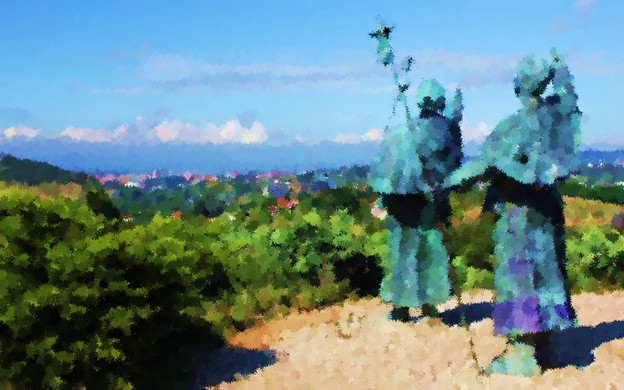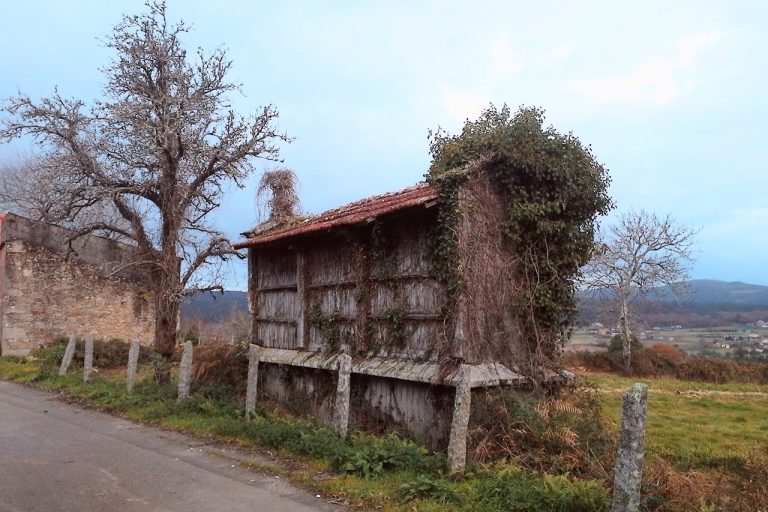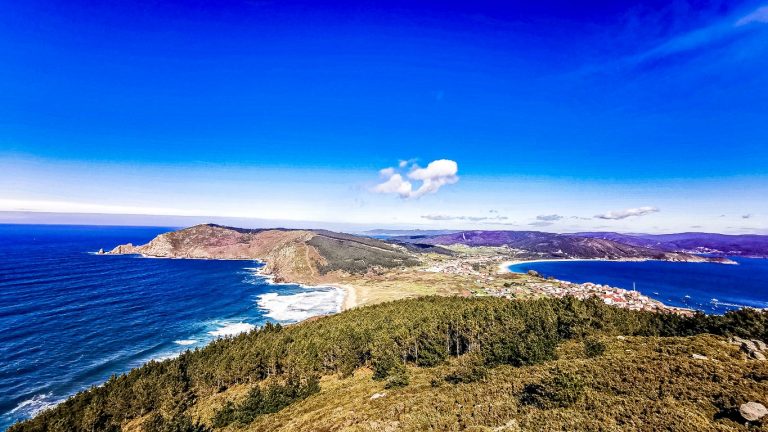
A New Stage Day – Beginning & Atmosphere
Morning mist still lies over the green hills of Galicia as you leave Arzúa. The town, known for its cheese and as the last larger stop before Santiago, remains behind you. Ahead lies a long but quiet stage – 34 kilometers bringing you step by step closer to the long-awaited goal: Monte do Gozo, the “Mount of Joy.”
The atmosphere is unique – a mix of fatigue, anticipation, and deep inner calm. With each step, the tension grows: soon you will see the towers of Santiago’s cathedral for the first time. The path leads you through forests, small villages, and quiet country roads – a transition marked less by outward splendor than by inner expectation.
Route & Elevation Profile
- Distance: approx. 34.1 km
- Elevation: +430 m / –460 m
- Difficulty: Medium to high – not due to steep climbs, but because of the length
- Special features: Many small hamlets, repeated crossings of the N-547, mental challenge due to the stage’s length
This stage requires less muscle strength than stamina. Those who walk it in one go feel the effort especially in the final kilometers. Many pilgrims split the route and stay overnight in Santa Irene or O Pedrouzo – but those seeking the big moment choose to spend the night at Monte do Gozo.











Variants & Small Detours
The classic route runs from Arzúa directly via O Pedrouzo to Monte do Gozo.
- O Pedrouzo Variant: Many pilgrims end the stage here (approx. 20 km), to walk calmly into Santiago the next morning. Advantage: more relaxed rhythm, time for the Pilgrim Mass.
- Santa Irene Variant: For those wishing to avoid the bustle of Pedrouzo, there are quiet small albergues here.
- Recommendation: For those with the strength, spending the last night before Santiago at Monte do Gozo is an unforgettable experience.
Description of the Way – With All Senses
You leave Arzúa slightly downhill, the cobblestones still glistening with morning dew. At the Fuente de los Franceses the water rushes quietly – a historic greeting to pilgrims of old.
Soon you reach As Barrosas – the name reveals it: a marshy stretch where every step after rain becomes a test of patience. The small chapel of San Lázaro and a monument to priest Ramón Pazos Seaje tell stories of the region.
Via O Raido and Preguntoño, where the little hermitage of San Paio stands, you walk through woods and fields. Soon a tunnel takes you safely under the national road – the hum of cars accompanying the rhythm of your steps.
The way flows gently on to Bebedeiro-Burres, where an old tavern has offered pilgrims rest for generations. From here begins the municipality of O Pino – the last district before Santiago. The landscape remains familiar: eucalyptus groves, scattered farmhouses, and small chapels again and again.
In Salceda the Camino pulses alongside the N-547. A small plaque commemorates Guillermo Watt, a pilgrim who lost his life here – a sobering moment of silence. The path continues through O Xen and Ras to A Brea, where bars and small guesthouses welcome you.
A stretch of woodland leads to the chapel of Santa Irene – a quiet place to pause. Beyond it, the path winds through eucalyptus forests to A Rúa. The name tells its form: a single street village with a small tourist office. Shortly afterward you reach bustling O Pedrouzo, the capital of O Pino.
Beyond Pedrouzo you enter the last great oak grove, passing the Brandelos river to Amenal. Here begins the hardest climb of the day: a shaded two-kilometer ascent up to Cimadevila, before the view of Santiago’s airport greets you. A modern contrast, but walking along the fence you sense: the city is near.
Through San Paio, past the church of San Pelayo, you reach Lavacolla – a place full of tradition. In its river, pilgrims once washed themselves to enter Santiago in purity. The Codex Calixtinus describes this movingly.
One final climb takes you to Vilamaior and then to San Marcos, where a small chapel and restaurants offer pilgrims strength. From here it’s only a few more steps – and then you stand upon Monte do Gozo.
Intermediate Villages & Special Features
| Village | Distance from Arzúa | Feature | Tip |
| As Barrosas | 2 km | Chapel of San Lázaro, Moncho monument | Short stop for a photo |
| Salceda | 10 km | Services along N-547, pilgrim memorial | Drink stop, caution crossing |
| Santa Irene | 19 km | Chapel of St. Irene, quiet spot | Ideal for peaceful overnight |
| O Pedrouzo | 20 km | Last major town before Santiago | Full services, many albergues |
| Amenal | 23 km | Beginning of last climb | Refill water & gather strength |
| Lavacolla | 30 km | Cleansing ritual in river, historical meaning | Brief moment of reflection |
| San Marcos | 33 km | Chapel, restaurants, view | Last rest before Monte do Gozo |
| Monte do Gozo | 34 km | First view of cathedral, pilgrim monument | Stay overnight & anticipation |
Packing & Shopping Tips
- Water: At least 2 liters – especially for the long stretch until Amenal.
- Food: Bread, Arzúa cheese, fruit – light provisions for the long walk.
- Clothing: Rain gear (frequent rain in Galicia), trekking poles for ascents and descents.
- Special tip: Carry a small towel – you may want to symbolically reenact the Lavacolla ritual.
Food, Lodging & Services
- Arzúa: Wide choice of hostels and hotels.
- Santa Irene: Small, quiet albergues.
- O Pedrouzo: Numerous accommodations (over 15 albergues, many pensions).
- Lavacolla: Several hotels and pilgrim hostels.
- Monte do Gozo: Monumental pilgrim complex (over 1,000 beds), private hostels, restaurants.
A stay at Monte do Gozo is special: a sense of community, proximity to Santiago, and anticipation of the final day.
Today’s Highlights
Lavacolla is one of the Camino’s mythical places. For centuries, pilgrims washed themselves in its river to enter Santiago pure and worthy. The Codex Calixtinus describes this in detail – a rite preparing body and soul for the goal.
At Monte do Gozo, a different feeling arises: joy, wonder, tears. Here pilgrims first saw the towers of the cathedral. A monument recalls the visit of Pope John Paul II in 1989, when he led a great youth gathering.
Beyond the monuments, above all remains the emotion: the first sight of the cathedral, the knowledge that you have made it. This moment has been the same for centuries – king, peasant, pilgrim, or modern hiker: here the heart rejoices.
Reflection at Stage’s End
Today you completed the longest and last great stage. Between fatigue and joy now lies the feeling of being almost there. What will stay more in your memory – the waters of Lavacolla that cleansed your thoughts, or the view from Monte do Gozo that made your heart leap?
📊 Tabular Overview
| Stage | Start | End | Distance | Elevation +/– | Difficulty | Key Villages |
| 32 | Arzúa | Monte do Gozo | 34.1 km | +430 / –460 | Medium-high (due to length) | As Barrosas, Salceda, Santa Irene, O Pedrouzo, Amenal, Lavacolla, San Marcos |
🌌 Camino of the Stars – Stage 32
Arzúa → As Barrosas → Preguntoño → Salceda → A Brea → Santa Irene → A Rúa → O Pedrouzo → Amenal → Cimadevila → San Paio → Lavacolla → Vilamaior → San Marcos → Monte do Gozo
Did you wash yourself at Lavacolla, spend the night at Monte do Gozo, or continue directly to Santiago? Share your experiences – your journey makes the Camino come alive.


